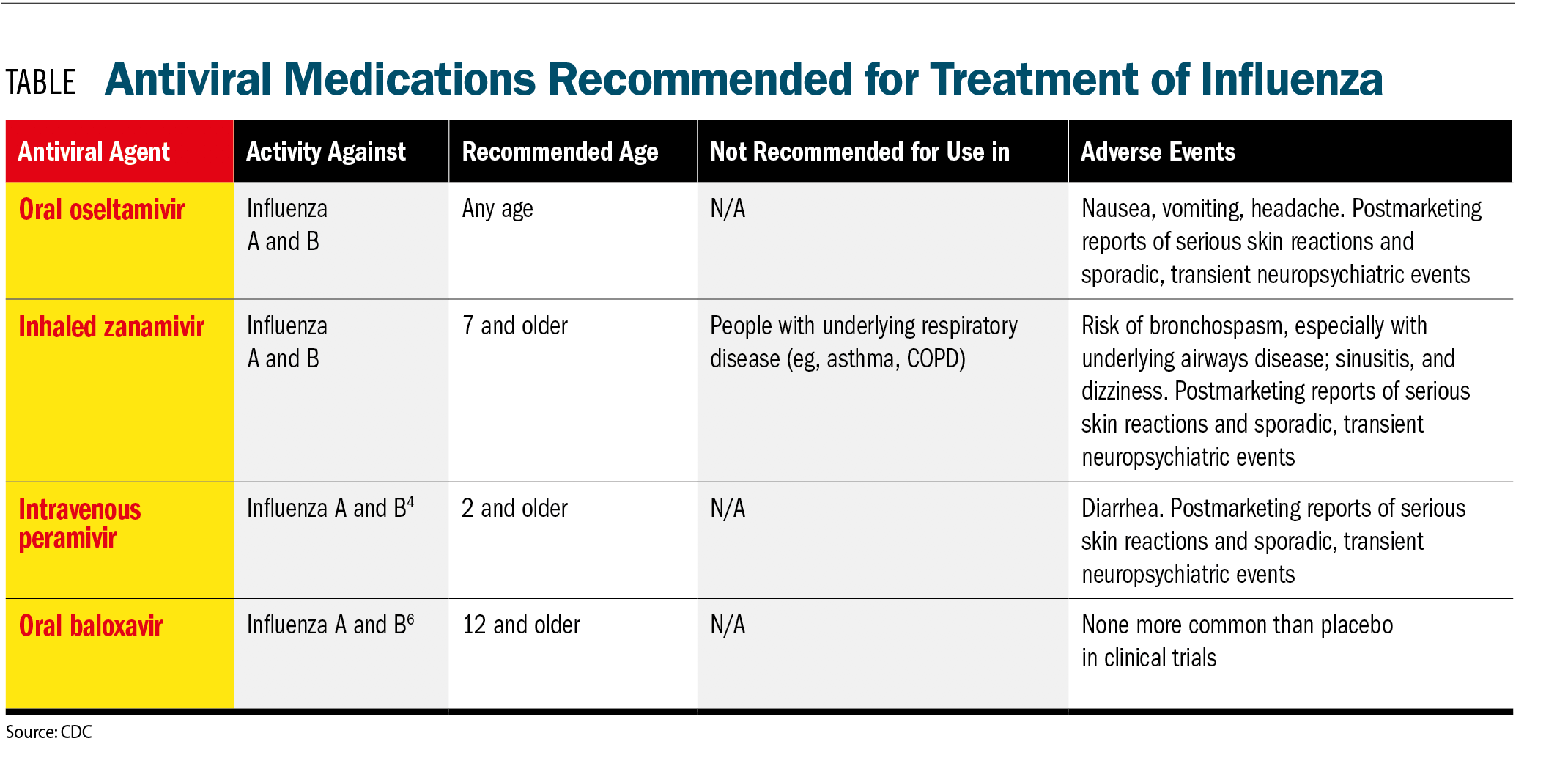Influenza Update: Antivirals Advance in Options, Indications
CDC reports seasonal influenza activity remains elevated and widespread throughout U.S.

Antiviral Medications Recommended for Treatment of Influenza

As pharmacies, doctors’ offices, and hospitals fill up with patients with influenza-like symptoms, the CDC reports seasonal influenza activity remains elevated and is widespread in most parts of the United States, with at least 22 flu-associated pediatric deaths through mid-January.
“In the last few weeks, influenza has really picked up across the country,” says Pritish K. Tosh, MD, an infectious diseases specialist at the Mayo Clinic in Rochester, MN.
The CDC estimates that, from Oct. 1 through Jan. 11, up to 7.3 million people have been sick with the flu; 2.9 million to 3.5 million have seen a doctor because of flu symptoms, and up to 83,500 people were hospitalized because of flu. For the week ending Jan. 19, there was a rate of about 14.8 hospitalizations per 100,000 people. The highest rate of hospitalization for that week was among adults 65 and older (38.3 per 100,000). The proportion of outpatient visits for influenza-like illness was 3.3%.
The Walgreens Flu Index reported Nebraska had the most flu activity in the week ending Jan. 26, followed by Kentucky, Mississippi, Texas, and Alabama. The index ranks the top markets and states for flu activity in the United States and Puerto Rico and is compiled using prescription data for antiviral medications used to treat flu across thousands of Walgreens and Duane Reade locations.
Which Antiviral?
This year’s top virus is the H1N1, but H3N2 viruses have been hitting the Southeast United States particularly hard, too. Tosh says the most commonly prescribed antiviral medication for flu treatment–oseltamivir phosphate (Tamiflu) appears to be working against the H1N1 virus.
“So far the CDC has not reported oseltamivir resistance,” Tosh tells Drug Topics, adding the CDC has not reported any resistant viruses this flu season.
The 2008 flu strain was resistant to oseltamivir, but that has not reoccurred, notes Andrew T. Pavia, MD, professor and chief of infectious diseases at the University of Utah in Salt Lake City. Pavia is on a committee of the Infectious Disease Society of America (IDSA) that has updated clinical practice guidelines for treating influenza.
“Resistance is an issue, but not a huge one yet,” says Pavia, senior author on the IDSA recommendations. “But it’s always out there as a threat.”
High levels of resistance to the antiviral drugs amantadine and rimantadine were seen with influenza A viruses in past seasons. These two drugs are not effective against influenza B, so they are not recommended by the CDC this season, Pavia says.
Antiviral medications are most effective when taken within the first 48 hours after the start of flu symptoms such as fever, chills, cough, sore throat, runny or stuffy nose, muscle aches, and headaches. In otherwise healthy patients, antivirals are not very useful if started more than 48 hours after onset of symptoms, Pavia says.
“But in hospitals, where illnesses last a lot longer, they’ve been given as late as five or seven days after onset,” he notes.
Oral oseltamivir can be prescribed for a patient of any age suffering from an influenza A or B strain. Adverse effects can include nausea, vomiting, and headache, and there have been some reports of serious skin reactions and sporadic transient neuropsychiatric events. In adults, the recommended dose is 75 mg twice a day for five days. For children over age 1, the dose varies by weight. Dosage can range from 30 mg twice daily for a child weighing 15 kg or less to a 75-mg dose twice daily for a child weighing more than 40 kg.
Tosh says oseltamivir reduces symptoms in otherwise healthy people, who are unlikely to have complications from influenza, and helps prevent severe outcomes in those with underlying conditions.
Inhaled zanamivir (Relenza) also works well against influenza A and B and can be used to treat those age 7 and older who do not have respiratory diseases like asthma and COPD, Pavia says. It should not be prescribed to those with allergies to milk proteins. Adverse reactions include bronchospasm, sinusitis, and dizziness. Some serious skin reactions and sporadic transient neuropsychiatric events were also reported. Treatment of two 5-mg inhalations lasts for five days. It’s primarily used for hospitalized patients and others who can’t swallow oral oseltamivir, he says.
Intravenous peramivir (Rapivab) can be used for influenza A and B4 in patients 2-years-old and older and is often used in hospital settings. For children age 2 to 12, one 12-mg/kg dose up to 600 mg is given via IV infusion for at least 15 minutes. Those age 13 and older should be given one 600 mg for at least 15 minutes. The most common side effect is diarrhea.
This year, pharmacists are seeing prescriptions for a new antiviral, baloxavir marboxil (Xofluza). It is for treatment of uncomplicated flu in people 12-years-old and older. It is not recommended for pregnant women, breastfeeding mothers, those with chronic illnesses, or hospitalized patients because it has not been studied in those groups.
Baloxavir is a one-dose tablet that can be used for influenza A and B6 in patients 12 and older who weigh at least 40 kg. Those weighing 40 kg to 80 kg should get one 40-mg dose, and those above 80 kg should receive one 80-mg dose. The most common adverse reactions are diarrhea and bronchitis.
Pavia notes that baloxavir’s side effects, which can also include headaches, are consistent with flu symptoms, so pharmacists need to advise patients and families of that.
He says pharmacists need to be familiar with side effects of all antivirals so they can be shared with patients.

2 Commerce Drive
Cranbury, NJ 08512
All rights reserved.